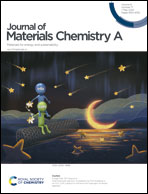Sodium phthalate as an anode material for sodium ion batteries: effect of the bridging carbonyl group†
Abstract
Organic electrode materials with high specific capacity and structural variety are promising for boosting the sodium-ion insertion/extraction kinetics for sodium-ion batteries. Sodium 5,5′-carbonylbis(isobenzofuran-1,3-dione) (SCID), a conjugated compound formed by the linkage of two sodium phthalate molecules via a bridging carbonyl group, has been designed and prepared. Theoretical calculation shows that the bridging carbonyl group in SCID can initiate the insertion of sodium ions and activate ortho-carbonyl functional groups. A high theoretical specific capacity of 240 mA h g−1, corresponding to the storage of four sodium ions, is predicted for the SCID compound with a bridging carbonyl group. The electrochemical performance of SCID is further improved through the incorporation of multi-walled carbon nanotubes (SCID@CNT) via a vacuum solution impregnation method. The SCID@CNT composite exhibits a reversible capacity as high as 182 mA h g−1 after 100 cycles at a current density of 50 mA g−1. This work provides a promising organic electrode material for sodium ion storage and sheds new light on the theoretical design of high-performance organic electrode materials for sodium ion batteries.



 Please wait while we load your content...
Please wait while we load your content...